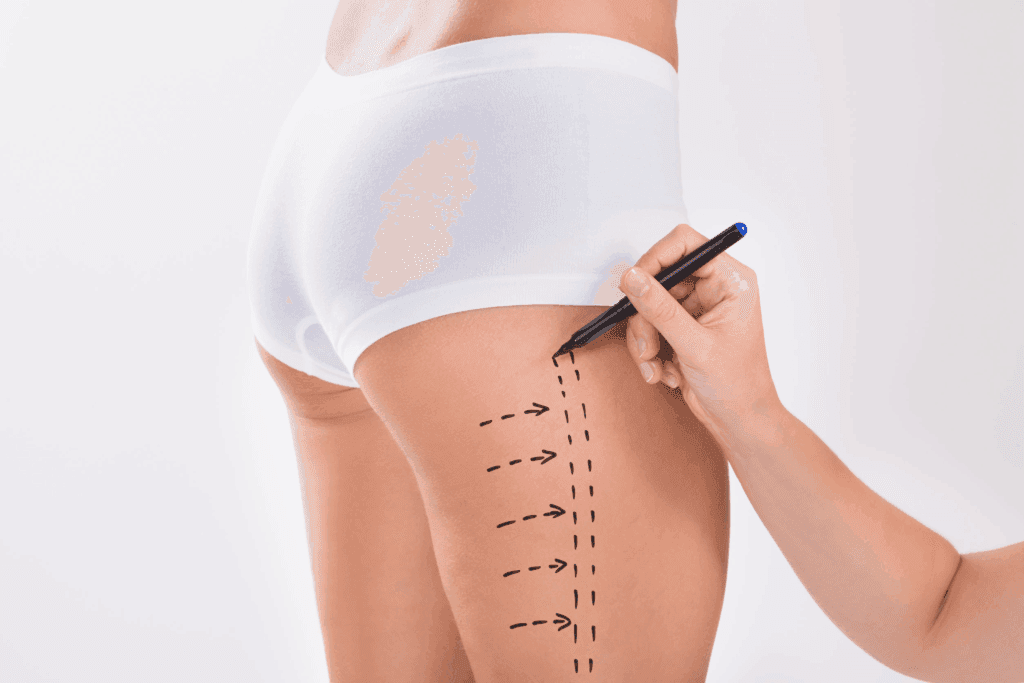Considering a thigh lift but unsure about the time commitment involved? You’re not alone. Thighplasty surgery, also known as a thigh lift, is a transformative procedure designed to reshape the thighs by removing excess skin and fat. However, understanding the duration of the surgery and the recovery timeline is crucial for planning and setting realistic expectations.
In this comprehensive guide, we’ll explore:
- IL average duration of thighplasty surgery based on the type of procedure.
- UN detailed breakdown of the recovery timeline, from immediate post-op to long-term healing.
- Factors that influence surgery duration and recovery.
- Tips for a smooth recovery and how to prepare for each stage.
- Potential complications and how to minimize risks.
By the end of this guide, you’ll have a clear understanding of what to expect before, during, and after your thighplasty surgery. Let’s dive in!

Sommario
1. Thighplasty Surgery Duration: What to Expect
1.1. Average Duration by Procedure Type
The duration of thighplasty surgery varies depending on the type of procedure and the extent of correction needed. Below is a breakdown of the average surgery times for different types of thigh lifts:
| Tipo di procedura | Average Duration | Factors Influencing Duration |
|---|---|---|
| Medial (Inner) Thigh Lift | 2 to 3 hours | Extent of excess skin and fat, incision length, and surgical technique. |
| Lateral (Outer) Thigh Lift | 2 to 4 hours | Complexity of reshaping outer thighs and hips, combined procedures. |
| Spiral Thigh Lift | 3 to 5 hours | Comprehensive reshaping of inner and outer thighs, as well as buttocks. |
| Mini Thigh Lift | 1 to 2 hours | Limited correction needed, smaller incisions, and less extensive reshaping. |
1.2. Factors Influencing Surgery Duration
Several factors can impact the duration of your thighplasty surgery. Understanding these factors can help you set realistic expectations:
| Fattore | Descrizione | Impact on Duration |
|---|---|---|
| Type of Thighplasty | Different procedures require varying levels of complexity and time. | More extensive procedures, like spiral thigh lifts, take longer. |
| Extent of Correction | The amount of excess skin and fat to be removed. | Greater correction needs more time for precise reshaping. |
| Surgical Technique | Techniques such as liposuction-assisted or laser-assisted thigh lifts. | Advanced techniques may add time but improve results. |
| Procedure combinate | Combining thighplasty with other surgeries, like a tummy tuck or buttock lift. | Additional procedures extend the overall surgery duration. |
| Esperienza del chirurgo | The skill and efficiency of the surgeon performing the procedure. | Experienced surgeons may complete the procedure more efficiently. |
1.3. Pre-Surgery Preparation and Its Impact on Duration
Proper preparation before your thighplasty surgery can help streamline the procedure and potentially reduce its duration:
| Preparation Step | Descrizione | Impact on Surgery Duration |
|---|---|---|
| Medical Evaluation | Comprehensive health assessment to ensure you’re fit for surgery. | Identifies potential issues that could prolong surgery. |
| Lab Tests | Blood tests and other diagnostics to assess your health status. | Ensures no last-minute delays due to health concerns. |
| Aggiustamenti dei farmaci | Adjusting or stopping certain medications as advised by your surgeon. | Prevents complications that could extend surgery time. |
| Smettere di fumare | Quitting smoking at least 6 weeks before surgery. | Improves healing and reduces risks of complications. |
| Hydration and Nutrition | Maintaining a healthy diet and staying hydrated before surgery. | Optimizes your body for surgery and recovery. |
Pro Tip: Follow your surgeon’s pre-surgery instructions diligently to minimize the risk of complications and ensure a smoother, potentially shorter procedure.
2. Thighplasty Recovery Timeline: Stage-by-Stage Guide
2.1. Immediate Post-Operative Period (First 48 Hours)
The first 48 hours after thighplasty surgery are critical for initial healing. Here’s what to expect and how to manage this period:
| Aspetto | What to Expect | Management Tips |
|---|---|---|
| Pain and Discomfort | Moderate to significant pain and discomfort around the incision sites. | Take prescribed pain medications as directed by your surgeon. |
| Gonfiore e lividi | Noticeable swelling and bruising in the thigh area. | Use ice packs and keep legs elevated to reduce swelling. |
| Limited Mobility | Difficulty moving around due to pain and tightness. | Have a caregiver assist you with mobility and daily tasks. |
| Drain Care | If surgical drains are placed, they will need to be emptied and monitored. | Follow your surgeon’s instructions for drain care and hygiene. |
| Indumenti compressivi | Wearing compression garments to support healing and reduce swelling. | Wear the garments as instructed, typically 24/7 initially. |
2.2. First Week of Recovery
The first week after thighplasty surgery involves gradual improvement but requires careful management:
| Aspetto | What to Expect | Management Tips |
|---|---|---|
| Gestione del dolore | Pain begins to subside but may still require medication. | Transition to over-the-counter pain relievers if approved by your surgeon. |
| Gonfiore e lividi | Swelling and bruising start to decrease but may still be present. | Continue using compression garments and elevation to aid healing. |
| Mobility | Gradual improvement in mobility, though strenuous activities should be avoided. | Begin light walking to promote circulation and healing. |
| Follow-Up Appointment | First post-op visit to monitor healing and remove drains if present. | Attend your appointment and discuss any concerns with your surgeon. |
| Wound Care | Incisions require careful cleaning and dressing changes. | Follow your surgeon’s instructions for wound care and hygiene. |
2.3. Weeks 2 to 4: Intermediate Recovery
During weeks 2 to 4, you’ll notice significant improvements in your recovery. Here’s what to expect:
| Aspetto | What to Expect | Management Tips |
|---|---|---|
| Pain and Discomfort | Pain continues to decrease, and discomfort becomes more manageable. | Use pain relief as needed and follow your surgeon’s recommendations. |
| Swelling | Swelling subsides further, and contours begin to take shape. | Continue wearing compression garments and avoid prolonged sitting. |
| Activity Level | Gradual return to light activities and possibly work, depending on the job’s physical demands. | Avoid heavy lifting and strenuous exercises until cleared by your surgeon. |
| Scar Care | Incisions begin to heal, and scars start to fade. | Use recommended scar treatments, such as silicone sheets or gels. |
| Appuntamenti di follow-up | Additional visits to monitor progress and address any concerns. | Attend all scheduled appointments and follow your surgeon’s advice. |
2.4. Weeks 4 to 12: Long-Term Recovery
During the long-term recovery phase, you’ll see continued improvements and the final results of your thighplasty:
| Aspetto | What to Expect | Management Tips |
|---|---|---|
| Swelling Resolution | Residual swelling continues to subside, revealing final contours. | Stay hydrated and maintain a healthy diet to support healing. |
| Activity and Exercise | Gradual return to normal activities and exercise routines. | Follow your surgeon’s guidelines for resuming physical activities. |
| Scar Maturation | Scars continue to fade and become less noticeable. | Continue using scar treatments and protect scars from sun exposure. |
| Final Results | Final results become apparent, with improved thigh contours and proportions. | Maintain a stable weight and healthy lifestyle to preserve results. |
| Appuntamenti di follow-up | Final post-op visit to assess results and address any lingering concerns. | Attend your final appointment and discuss long-term care with your surgeon. |
Pro Tip: Keep a recovery journal to track your progress, note any concerns, and stay on top of follow-up appointments. This can help you stay organized and ensure a smooth recovery.

3. Factors Influencing Recovery Timeline
3.1. Individual Health and Healing
Your overall health and healing capacity play a significant role in your recovery timeline:
| Fattore | Impact on Recovery | Tips for Optimization |
|---|---|---|
| General Health | Good overall health promotes faster healing and reduces complications. | Maintain a balanced diet, stay hydrated, and follow a healthy lifestyle. |
| Chronic Conditions | Conditions like diabetes or autoimmune disorders can slow healing. | Work with your healthcare provider to manage chronic conditions effectively. |
| Age | Younger individuals may heal faster than older adults. | Follow your surgeon’s advice for age-specific recovery care. |
| Nutrition | Adequate nutrition supports tissue repair and reduces swelling. | Focus on protein-rich foods, vitamins, and minerals to aid healing. |
3.2. Type of Thighplasty Procedure
The type of thighplasty procedure you undergo will influence your recovery timeline:
| Tipo di procedura | Cronologia del recupero | Key Considerations |
|---|---|---|
| Medial Thigh Lift | 2-4 weeks for initial recovery; full recovery in 3-6 months. | Focus on managing swelling and following scar care protocols. |
| Lateral Thigh Lift | 2-4 weeks for initial recovery; full recovery in 3-6 months. | Gradual return to activities, with attention to incision care. |
| Spiral Thigh Lift | 3-6 weeks for initial recovery; full recovery in 6-12 months. | More extensive recovery due to the comprehensive nature of the procedure. |
| Mini Thigh Lift | 1-2 weeks for initial recovery; full recovery in 4-6 weeks. | Shorter recovery due to the less extensive nature of the procedure. |
3.3. Lifestyle and Post-Op Care
Your lifestyle choices and adherence to post-operative care instructions significantly impact your recovery:
| Fattore | Impact on Recovery | Tips for Success |
|---|---|---|
| Smoking | Impairs healing and increases the risk of complications. | Avoid smoking for at least 6 weeks before and after surgery. |
| Alcohol Consumption | Can interfere with medications and slow down healing. | Avoid alcohol for at least 1 week before and after surgery. |
| Physical Activity | Strenuous activity can strain incisions and delay healing. | Follow your surgeon’s guidelines for gradually resuming activities. |
| Indumenti compressivi | Support healing and reduce swelling. | Wear compression garments as instructed by your surgeon. |
| Appuntamenti di follow-up | Ensure proper healing and address any concerns. | Attend all scheduled follow-up visits with your surgeon. |
Pro Tip: Create a post-op care plan that includes diet, activity restrictions, and follow-up appointments. This will help you stay on track and achieve the best possible results.
4. Tips for a Smooth Recovery and Optimal Results
4.1. Preparing Your Home for Recovery
Preparing your home before surgery can make your recovery more comfortable and manageable:
| Preparation Step | Why It Matters | Tips |
|---|---|---|
| Recovery Area | Provides a comfortable and safe space for rest and healing. | Set up a cozy area with pillows, blankets, and easy access to essentials. |
| Medications and Supplies | Ensures you have everything you need for pain management and wound care. | Stock up on prescribed medications, ice packs, and wound care supplies. |
| Assistance | Having someone to help with daily tasks can ease your recovery. | Arrange for a caregiver or family member to assist you during the first few days. |
| Mobility Aids | Helps with movement and reduces strain on incisions. | Consider using a cane or walker if needed for stability. |
| Nutrition | Supports healing and provides necessary nutrients for recovery. | Prepare healthy meals and snacks in advance for easy access. |
4.2. Managing Pain and Discomfort
Effective pain management is crucial for a smooth recovery. Here are some tips:
| Tip | Why It Matters | How to Implement |
|---|---|---|
| Prescription Medications | Helps manage pain and discomfort during the initial recovery phase. | Take prescribed pain medications as directed by your surgeon. |
| Ice Therapy | Reduces swelling and numbs the area to alleviate pain. | Apply ice packs to the thigh area for 15-20 minutes at a time, several times a day. |
| Elevation | Promotes circulation and reduces swelling. | Keep your legs elevated when resting or sleeping. |
| Indumenti compressivi | Supports the healing process and minimizes swelling. | Wear compression garments as instructed by your surgeon. |
| Relaxation Techniques | Helps reduce stress and promotes overall well-being. | Practice deep breathing, meditation, or gentle stretching. |
4.3. Maintaining Long-Term Results
To ensure your thighplasty results last, follow these long-term maintenance tips:
| Tip | Why It Matters | How to Implement |
|---|---|---|
| Healthy Diet | Prevents weight gain and maintains your new contours. | Focus on balanced nutrition with plenty of protein, fruits, and vegetables. |
| Regular Exercise | Keeps your body toned and supports overall health. | Incorporate strength training and cardio into your routine. |
| Hydration | Supports skin elasticity and overall health. | Drink at least 8 glasses of water daily. |
| Follow-Up Visits | Ensures proper healing and addresses any concerns. | Attend all scheduled follow-up appointments with your surgeon. |
| Scar Care | Minimizes the appearance of scars and promotes healing. | Use silicone sheets or gels and protect scars from sun exposure. |
Pro Tip: Maintain open communication with your surgeon throughout your recovery journey. Address any concerns promptly to ensure a successful outcome.
Conclusion: Key Takeaways for Your Thighplasty Journey
Key Takeaways
- Thighplasty surgery duration varies based on the type of procedure, ranging from 1 to 5 hours. More extensive procedures, like spiral thigh lifts, take longer.
- IL recovery timeline involves multiple stages, from immediate post-op care to long-term healing, with full recovery taking up to 6-12 months.
- Factors influencing recovery include your overall health, type of procedure, lifestyle choices, and adherence to post-op care instructions.
- Preparing your home and lifestyle for recovery can significantly improve your healing experience and results.
Next Steps
Ready to take the next step in your thighplasty journey? Here’s what you can do:
- Assess Your Goals: Determine what you hope to achieve with thighplasty and whether it aligns with your expectations.
- Research Surgeons: Look for board-certified plastic surgeons with experience in thighplasty procedures.
- Schedule a Consultation: Meet with a surgeon to discuss your goals, evaluate your candidacy, and receive a personalized treatment plan.
- Plan for Recovery: Prepare your home and schedule time off work to ensure a smooth recovery process.
- Visit Squadra chirurgica: Connect with qualified surgeons and access expert guidance for your thighplasty journey.
A Squadra chirurgica, we’re committed to helping you achieve your aesthetic goals safely and effectively. Contact us today to explore your options and take the first step toward a more confident you!
Domande frequenti (FAQ)
1. How long does thighplasty surgery take?
The duration of thighplasty surgery varies depending on the type of procedure. On average, it takes 1 to 5 hours, with more extensive procedures like spiral thigh lifts taking longer.
2. What is the recovery timeline for thighplasty?
The recovery timeline involves several stages:
- First 48 hours: Immediate post-op care with pain management and limited mobility.
- First week: Gradual improvement in pain and swelling, with light activities resumed.
- Weeks 2-4: Significant reduction in swelling, return to work, and light exercise.
- Weeks 4-12: Continued healing, with final results becoming apparent.
3. How can I speed up my thighplasty recovery?
To speed up recovery:
- Follow your surgeon’s post-op instructions closely.
- Maintain a healthy diet and stay hydrated.
- Wear compression garments as directed.
- Avoid smoking and alcohol.
- Attend all follow-up appointments.
4. When can I return to work after thighplasty?
Most patients can return to work within 2 to 4 weeks, depending on the type of procedure and the physical demands of their job. Follow your surgeon’s recommendations for a safe return.
5. What are the risks of thighplasty surgery?
Potential risks include:
- Infezione at the incision sites.
- Bleeding during or after surgery.
- cicatrici that may be visible.
- Poor wound healing or delayed healing.
- Asimmetria in thigh contours.
Choosing a qualified surgeon and following pre- and post-op instructions can minimize these risks.
6. How much does thighplasty surgery cost?
The cost of thighplasty varies depending on the type of procedure, surgeon’s experience, and geographic location. On average, prices range from $5,000 to $15,000. Request a detailed cost breakdown during your consultation.
7. Is thighplasty covered by insurance?
Thighplasty is typically considered a cosmetic procedure and is not covered by insurance. However, if the procedure is medically necessary, such as to address skin infections or mobility issues, insurance may provide partial coverage.
8. What should I expect during my thighplasty consultation?
During your consultation, your surgeon will:
- Assess your health and discuss your goals.
- Explain the procedure and its risks.
- Provide a cost estimate and financing options.
- Show before-and-after photos of previous patients.
- Answer any questions you may have.
Bring a list of questions and take notes to ensure you cover all your concerns.
Our Surgeons and Affiliated Professionals
At Surgyteam, we are proud to collaborate with a distinguished team of medical professionals, each bringing a wealth of expertise and a commitment to patient-centered care.
- Dr. Mehmet Fatih Okyay (Dr. MFO): Plastic, Reconstructive and Aesthetic Surgery Specialist. Co-founder of Surgyteam. FEBOPRAS certified. (https://www.dr-mfo.com/)
- Dr. Selçuk Yılmaz: Plastic, Reconstructive and Aesthetic Surgery Specialist. (https://drselcukyilmaz.com)
- Dr. Ebru Okyay: Dermatology Specialist. (https://drebruokyay.com/)
- Dr. Mustafa Keleş: Aesthetic, Plastic and Reconstructive Surgery Specialist. (https://www.medstar.com.tr/doktorlar/mustafa-keles/)
- Dr. Boray Yücel: Plastic, Reconstructive and Aesthetic Surgery Specialist. (https://borayucel.com/)
- Dr. Sibel Atalay: Plastic, Reconstructive and Aesthetic Surgery Specialist. Clinic with International Health Tourism Authorization Certificate. (https://www.sibelatalay.com.tr/)
- Dr. Mert Meral: Plastic, Reconstructive and Aesthetic Surgery Specialist. EBOPRAS certified. (https://mertmeral.com/)
To learn more about Surgyteam and how we can assist you, please visit our website:
https://surgyteam.com/
Disclaimer: This blog post is intended for informational purposes only and does not constitute medical advice. Costs are estimates and can vary. Always consult with a qualified medical professional for personalized advice and treatment.



